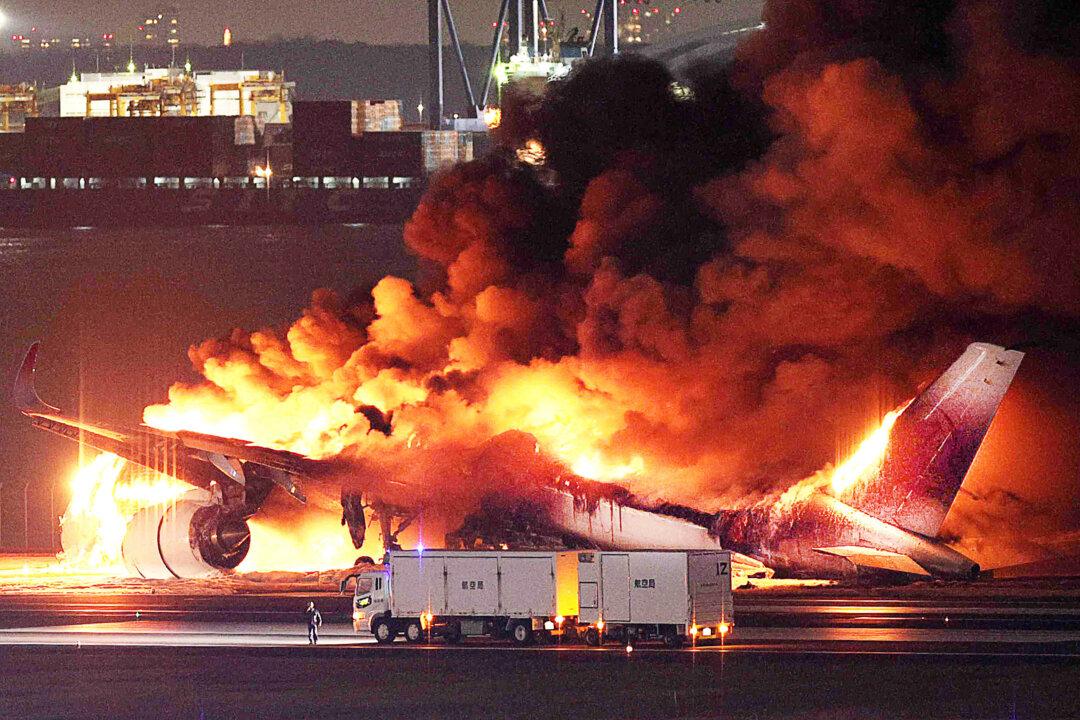The captain of the coast guard plane, a Bombardier Dash-8, escaped the blaze, but his five crew members perished. Meanwhile, everyone on board the burning Airbus was evacuated safely, in record time.
The route between Sapporo, Hokkaido, and Tokyo is one of the busiest in the world, and the plane was full of passengers on their New Year’s vacation. After an uneventful flight, the plane touched down. Then it hit the coast guard plane, which exploded in a fireball. With a loud sound, the Airbus’s engine and wings caught fire, as did the back of the aircraft. The fire spread quickly, smoke began to seep into the cabin, and passengers began to scream.
As more passengers realized the danger, they began “yelling at the flight attendants to open the doors. It was chaotic,” said Mr. Hayashi. “It wasn’t like full-on pushing, but it was the first time I’ve seen Japanese people push each other.”
A teenage passenger seated to the right of the plane’s center told Japan’s Fuji News Network that he “felt the heat” after the crash and that the cabin was dark, while the window turned orange from the fire outside. Flight attendants’ commands were interspersed with the cries of young children. In the chaos, a child cried out, “Please, open the door!”
At this point, the airplane’s public address system malfunctioned, and the flight attendants used emergency loudspeakers intending to calm the passengers. It took three to five minutes to open the doors.
JAL said in the aftermath that only three of the plane’s eight exit doors were used in the evacuation because fire outside made the other doors unsafe.
Flight attendants had warned passengers not to stop for luggage. Hiroshi Kaneko, 67, a philosophy professor who was returning from a visit to his mother, told the Wall Street Journal he took only a small backpack containing his valuables, leaving a large bag behind, and then slid down the front-right chute.
Mr. Kaneko said the passengers around him did not panic at the time. He felt more frightened after seeing video footage of the scene later. The delay in opening the hatch was justified, he told the Wall Street Journal. “It takes time to make sure doors are safe, and it is dangerous to open a door with a flame.”
Mr. Yamamoto, 40, was returning home from a trip to Hokkaido with his children, and was seated in the front of the plane. He told the Japanese media afterward that the flight went smoothly after leaving New Chitose Airport, but when he landed at Haneda, he heard a loud noise, and the plane suddenly braked and almost skidded without slowing down. He saw the plane on fire and thought a bird had gotten into the engine.
“To be honest, when I was in the airplane, I felt so hot that I thought I wouldn’t be able to survive,” another passenger, Mr. Kimura said. He felt the flames growing as flight attendants shouted instructions to stay calm and leave luggage behind.
Not knowing what was happening, everyone bent over, covered their mouths and noses, and followed the crew’s instructions.
Mr. Yamamoto said he was told to “get out” five to ten minutes later, and slid down the escape chute to the outside of the plane.
‘Textbook’ Operation in Air Evacuation
Japan Airlines said the evacuation was completed at 6:05 p.m. It took only 18 minutes from the crash time of 5:47 p.m. to get all 379 people to safety.The day after the accident, hashtags “Thank You, JAL” and “JAL is the pride of Japan” were trending on social media.
The professional, swift, and calm emergency response by the JAL crew and the high level of cooperation by the passengers won international acclaim.

According to a Nikkei Asia report on Jan. 4, JAL’s 90-second drills were crucial in saving lives from the flaming jet. The 90-second rule is an international standard for aircraft design stipulating that all passengers must be able to evacuate within 90 seconds after emergency doors are opened and evacuation slides are inflated.
According to JAL, the company annually conducts crew training to evacuate passengers within 90 seconds. Employees act as passengers and conduct drills for various scenarios, such as the presence of children on board, and darkness inside or outside the plane.
“The cabin crew must have done an excellent job. There don’t seem to be any carry-ons. It was a miracle that all the passengers got off,” Paul Hayes, director of air safety at UK-based aviation consultancy Ascend by Cirium, told The Guardian.
“Passengers seemed to have followed instructions in a textbook manner,” airline industry expert Terence Fan told AFP.
Those on board were commended for leaving their bags behind, which is also in line with safety instructions to dispose of belongings in case of emergencies.
Ed Galea, a professor at the University of Greenwich and director of the Center for Fire Safety Engineering, told BBC, “If people tried to take their cabin luggage, that’s really dangerous because they would slow down the evacuation.”
CNN International anchor John Vause said in a Jan. 3 broadcast: “For many, this was a crew doing what they had to do. They were trained for it. This was their job: get everyone out in 90 seconds. But still, it’s pretty amazing they got everyone out so quickly.”
“What’s more of a miracle is the passengers keeping their wits about them and not panicking.”






